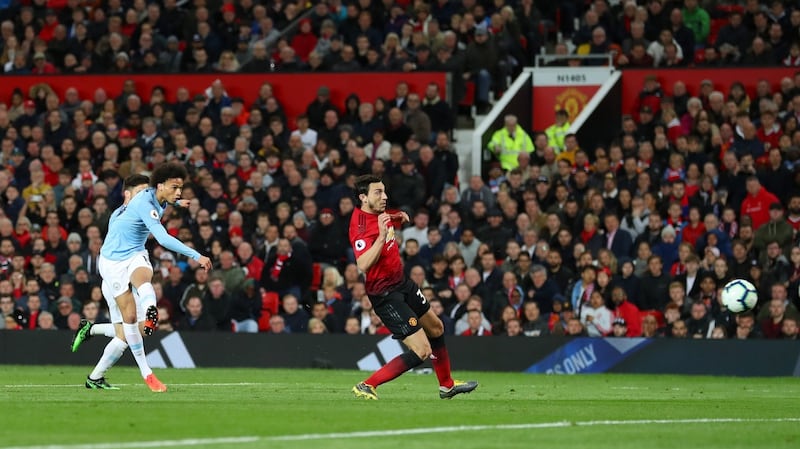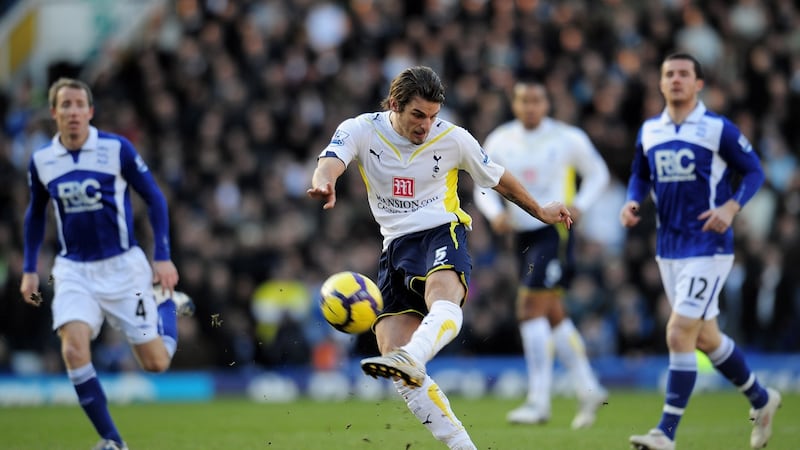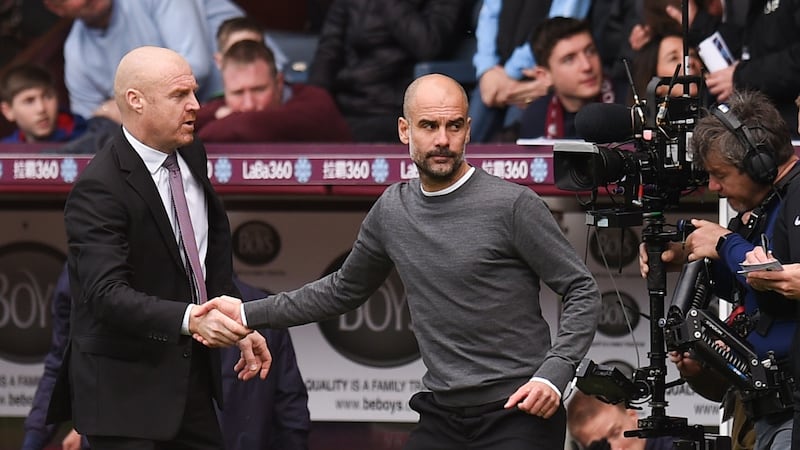When Liverpool scored after 15 seconds against Huddersfield Town on Friday night, one common reaction would have been to bemoan the lack of competitiveness in the Premier League, and wonder if there was anything else on television. But this was one of the most interesting goals you'll see all season, and it's worth analysing what happened in detail.
From the kick-off, Huddersfield go back to holding midfielder Jon Gorenc Stankovic, who plays it right to central defender Christopher Schindler. Daniel Sturridge closes Schindler down, and Sadio Mane is close to the right back Tommy Smith, so Schindler plays it back to goalkeeper Jonas Lössl and runs towards the right corner of the Huddersfield box to make himself available for a return pass.
Except Sturridge has angled his run to close down Lössl such that he is also threatening that return pass to Schindler, and he has Mane in support. The other centre half, Terence Kongolo, has split to the left corner of the Huddersfield box, but Mohamed Salah is close by: too risky. The easiest available pass is up the middle to Stankovic, who is unmarked and appears to be in space.
Appearances can be deceptive. Naby Keïta is a good 15 yards away from Stankovic, on the far side of another Huddersfield midfielder, Jonathan Hogg. Hogg is pointing and gesticulating to team-mates and paying no attention to Keïta, whose orientation at this moment seems to be entirely defensive.
In fact Keïta is waiting to spring the trap. As the ball goes back to Lössl, he knows his team-mates are leaving the goalkeeper with only two options: hit it long, or pass to Stankovic in the middle. At the precise instant he sees Lössl has chosen the short rather than the long pass, Keïta takes off, goes past Hogg before Hogg realises what is happening, and arrives on Stankovic’s blindside as he turns with the ball and attempts to pass. Keïta blocks the ball to the nearby Salah, runs into the area, collects the return pass and scores.
The interesting thing about the goal was that you’d never have seen one like it in the Premier League of 10 years ago. These 15 seconds showed some of the ways the game has changed.
First, Huddersfield were trying to play the ball out from the back, rather than simply humping it into Liverpool’s half. This mightn’t seem like a very clever idea for a team like Huddersfield: maybe they’d be better off playing long ball rather than trying to be some kind of sad cargo-cult Barcelona. Sure, if Lössl had just launched it they wouldn’t have conceded this particular goal. But would they have been any more successful over the course of the season? Cardiff have been true to the old-school approach, and it hasn’t done them much good.
There's no runner there, the ball's just, there's only one ball, close it down!
Huddersfield would have got away with that opening sequence against most teams. This time they were destroyed by the superb organisation of Liverpool’s press – most obviously the timing of Keïta’s burst forward into the challenge, but also the angle Sturridge chose to cut off, the positioning of Salah and Mane. It was a team goal to which four players contributed, and two of them didn’t even touch the ball.
This is what top-level football is about now – team moves so rapid and automatic you have to watch it back several times to figure out what just happened.
The game is more collective than ever, yet the players are still judged and criticised as individuals. Look at Sky's coverage of the Manchester derby last week. The senior analysts were Roy Keane, who was the best midfielder in the league 20 years ago, and Graeme Souness, who was the best midfielder in the league 20 years before that.
At one point, Keane lost patience with Gary Neville's reluctance to condemn United defenders Luke Shaw and Matteo Darmian for their actions on the City goals.

“It’s two yards! At least close him down . . . if the guy gets a shot off no problem, get out to him! Like your life depends on it! . . . Gary, you’re on about the runners. There’s an obsession about players – oh there’s people running – but the ball’s . . . that’s the danger! There’s no runner there, the ball’s just, there’s only one ball, close it down! Don’t worry what’s going on over there or over there, close the ball down! That’s the basics!”
Keane’s scorn is always intensely watchable and the clip of this exchange has since had more than a million views on YouTube. And you might find yourself nodding along – why didn’t Shaw make a challenge, why couldn’t Darmian get a bit closer to Leroy Sané? Why won’t these young men tackle and put their bodies on the line, like they did in the good old days?
You’d almost forget that these were City’s 156th and 157th goals of the season – an all-time record in English football. How do they seem to find it so very easy to score? Is it because most of their opponents are cheats and bluffers, so rotten from too much money and first-class travel and Dr Dre headphones that they have forgotten or stopped caring about the basics of football?
Or might it have something to do with what City are doing? Their game is about systematically presenting the opponent with a bad choice, and a worse choice. Which is it going to be?
You are Luke Shaw and Bernardo Silva is coming at you on the edge of the box. Do you challenge him and risk getting dribbled or maybe conceding a penalty, or do you stand off and risk him shooting past you? You decide that David de Gea will probably have the shot covered and . . . congratulations it is 1-0 to City and you are already trending on Twitter, and not in a good way.
You are Matteo Darmian and Raheem Sterling is bearing down on your defensive line while Sergio Agüero makes a run in between you and Chris Smalling. Do you follow Agüero's run and leave space for the advancing Sané, or do you guard the space and let Sterling play Agüero in for a one-on-one? You decide to go with Agüero, then you have to backpedal when Sterling passes to Sané and . . . congratulations, it is 2-0 to City and you are about to have your manhood questioned on live television by the world's funniest, angriest football pundit.
There is a seductive simplicity about the notion that it’s all about character and desire: desire to get to the ball, to make the tackle, to block the shot. But this ignores how the game has changed over the last few years. There’s still only one ball – but that ball is a lot more elusive than it was in Roy Keane’s day.
Against City you either press as a team, or not at all
If you want to understand the evolution of the sport, look at some historical comparisons. Over the last 10 years, the number of passes in the Premier League has increased by more than 25 per cent. In 2007-8, teams passed the ball 358 times per game on average. In 2017-18, the average was 453 – nearly 100 passes more per game, per team.
The trend towards more passes is magnified at the top end. Arsenal were the top passers in 2007-8, averaging 495 passes per game. Last season, Manchester City’s average was 743: a full 50 per cent more than the best passing team of 10 years ago!
How do you get close to the ball when it’s moving that fast? You can do what Keane urged the United players to do, “ignore the runners” and “not worry about what’s going on over there and over there”, focus on the ball and try to “get to it, like your life depends on it” – but if you press and your team-mates don’t, then City will pass it around you and make you look foolish, and after chasing them for an hour you will find you can hardly move your legs. And that’s when they’ll start running up the score. Against City you either press as a team, or not at all; against a system like this the individual is powerless.
The rise of system football means that the English league today has less broken play, and more periods of controlled possession. In 2008, Premier League teams averaged almost 24 tackles per game. By 2017-18 the average number of tackles had dropped by almost a third, to just over 16 per game. Huddersfield Town topped the tackle table in 2017-18, with 744.
The team with the lowest number of tackles in 2008 was Reading, with 800 – so the team that made the fewest tackles 10 years ago tackled more than the team that makes the most tackles today. Interceptions have also declined, by about one-sixth. Less broken play means fewer chances for individuals to seize the moment and be the hero.
Another evolution involves crossing and the players who do it. If you compare crossing statistics from 2007-8 and this season, you notice two big changes. First, the overall numbers are down. The top 20 crossers in 2008 averaged 6.5 crosses per game, whereas in 2018-19 this group is down to 4.5 crosses per game – a drop of nearly one-third. Today’s teams don’t like giving the ball away with hit-and-hope crosses.
Second, it's a different type of player doing the crossing. The 2008 top crossers list was made up of wingers and midfielders – names like David Bentley, Stewart Downing, Ashley Young (who was a winger back then), etc. There is only one full back in the top 20: Nicky Shorey, then of Reading. In 2018-19, eight of the top 20 crossers are full backs, with Everton's Lucas Digne leading the way, and Jose Holebas, Kieran Trippier, Trent Alexander-Arnold and (converted full back) Ashley Young also in the top 10.

If you want full backs to cross a lot then you had better hold possession long enough to give them time to get into the opposition third. That's one reason why, 20 years ago, full backs seldom crossed the halfway line – the other being that few players were fit enough to keep running the length of the pitch for 90 minutes. Even in 2008, defensive full backs were the norm and a player like Dani Alves – who invented the template for the modern attacking full back – still seemed like he'd been beamed back from the future.
The top managers these days are far too respectful of each other
For the state of the art in 2018-19, look at Liverpool. Andy Robertson and Trent Alexander-Arnold are two of the most dangerous old-school wingers in the Premier League – which is to say, players who set up goals for team-mates by crossing from high positions. Robertson's 11 assists are already a new Premier League record for a defender; Alexander-Arnold has nine so he too could easily match the old record of 10 this season.
The only "true" wingers with comparable assist numbers are Sané and Ryan Fraser. Robertson and Alexander-Arnold have done this while simultaneously being part of the meanest defence in the division. Moreover, despite playing with two full backs who operate as wingers and in theory leave huge spaces behind to be exploited, Liverpool have yet to concede a single goal on the counterattack in the Premier League all season.
The level of tactical organisation required to pull this off is phenomenal. It underlines the reality that football is less and less a battle between individuals, and more and more a contest of systems. At some point maybe the ex-pros who analyse the game on television will understand this and stop judging players by the standards of a sport that no longer exists.
Mind games: another lost art that people miss from title races of old. The top managers these days are far too respectful of each other.
It was interesting, last week, to see Pep Guardiola's response to Ole Gunnar Solskjær's mildly provocative comments to the effect that City are a great team for kicking you to the ground the second they lose the ball. Everybody who watches City knows this is true – Raheem Sterling provided another good example of the art on Sunday, when he lost the ball to Ashley Barnes on the edge of Burnley's box, then jumped on Barnes's back to snuff out the potential counterattack, escaping a booking.

But Guardiola doesn’t like people talking about it because then referees might start giving yellow cards for those tactical fouls. He reacted with genuine annoyance, and soon afterwards journalists were receiving data from City’s press team showing that actually, United foul more than City.
It made you wonder if there is a vulnerability there, should other managers decide to play on it. That was what José Mourinho did as manager of Real Madrid: knowing that Guardiola is already highly strung, he decided to rack up the tension to the maximum; if he's a worrier then let's give him something to worry about. Let's troll and needle and provoke until he's too tormented to think straight.
Mourinho's tactics worked, after a fashion. Madrid won the title in 2012 and a burnt-out Guardiola left Barcelona to go on sabbatical. So why haven't Jürgen Klopp or Mauricio Pochettino been tempted to crank up the psychological pressure on Pep?
It could be a question of personality. Klopp, plainly, is no Mourinho. Last week he did a "Jürgen Klopp answers the web's most-searched questions about him" video for Soccer AM. Asked "What is your favourite film?" his answer was immediate and decisive: "Forrest Gump! " Somewhere out there, José felt his lip curl without knowing why.
Or it could be that they know what they have in common is more important than what divides them. In one sense Pep is Klopp’s biggest rival. But in another, he’s a kindred spirit – one of a small group of people in English football who fully understands what he’s trying to do. One day the rest of the culture might catch up with the pair of them.


















